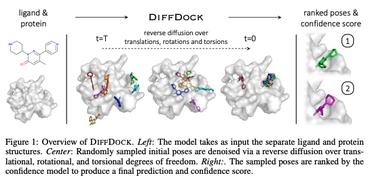Search Results for author: Ron O. Dror
Found 10 papers, 5 papers with code
Enhancing Ligand Pose Sampling for Molecular Docking
1 code implementation • 30 Nov 2023 • Patricia Suriana, Ron O. Dror
To train scoring functions-and to perform molecular docking-one must generate a set of candidate ligand binding poses.
FlexVDW: A machine learning approach to account for protein flexibility in ligand docking
no code implementations • 20 Mar 2023 • Patricia Suriana, Joseph M. Paggi, Ron O. Dror
Here we present a deep learning model trained to take receptor flexibility into account implicitly when predicting van der Waals energy.
Systematic Analysis of Biomolecular Conformational Ensembles with PENSA
1 code implementation • 6 Dec 2022 • Martin Vögele, Neil J. Thomson, Sang T. Truong, Jasper McAvity, Ulrich Zachariae, Ron O. Dror
PENSA implements various methods to systematically compare the distributions of these features across ensembles to find the significant differences between them and identify regions of interest.
Equivariant Graph Neural Networks for 3D Macromolecular Structure
2 code implementations • 7 Jun 2021 • Bowen Jing, Stephan Eismann, Pratham N. Soni, Ron O. Dror
Representing and reasoning about 3D structures of macromolecules is emerging as a distinct challenge in machine learning.
ATOM3D: Tasks On Molecules in Three Dimensions
3 code implementations • 7 Dec 2020 • Raphael J. L. Townshend, Martin Vögele, Patricia Suriana, Alexander Derry, Alexander Powers, Yianni Laloudakis, Sidhika Balachandar, Bowen Jing, Brandon Anderson, Stephan Eismann, Risi Kondor, Russ B. Altman, Ron O. Dror
We implement several classes of three-dimensional molecular learning methods for each of these tasks and show that they consistently improve performance relative to methods based on one- and two-dimensional representations.
Protein model quality assessment using rotation-equivariant, hierarchical neural networks
no code implementations • 27 Nov 2020 • Stephan Eismann, Patricia Suriana, Bowen Jing, Raphael J. L. Townshend, Ron O. Dror
Proteins are miniature machines whose function depends on their three-dimensional (3D) structure.
Geometric Prediction: Moving Beyond Scalars
no code implementations • 25 Jun 2020 • Raphael J. L. Townshend, Brent Townshend, Stephan Eismann, Ron O. Dror
This novel and data-efficient ability to predict real-world geometric tensors opens the door to addressing many problems through the lens of geometric prediction, in areas such as 3D vision, robotics, and molecular and structural biology.
Hierarchical, rotation-equivariant neural networks to select structural models of protein complexes
no code implementations • 5 Jun 2020 • Stephan Eismann, Raphael J. L. Townshend, Nathaniel Thomas, Milind Jagota, Bowen Jing, Ron O. Dror
Predicting the structure of multi-protein complexes is a grand challenge in biochemistry, with major implications for basic science and drug discovery.
Transferrable End-to-End Learning for Protein Interface Prediction
no code implementations • 27 Sep 2018 • Raphael J. L. Townshend, Rishi Bedi, Ron O. Dror
While there has been an explosion in the number of experimentally determined, atomically detailed structures of proteins, how to represent these structures in a machine learning context remains an open research question.
End-to-End Learning on 3D Protein Structure for Interface Prediction
1 code implementation • NeurIPS 2019 • Raphael J. L. Townshend, Rishi Bedi, Patricia A. Suriana, Ron O. Dror
Despite an explosion in the number of experimentally determined, atomically detailed structures of biomolecules, many critical tasks in structural biology remain data-limited.
 Open-Ended Question Answering
Open-Ended Question Answering
 Protein Interface Prediction
+1
Protein Interface Prediction
+1


